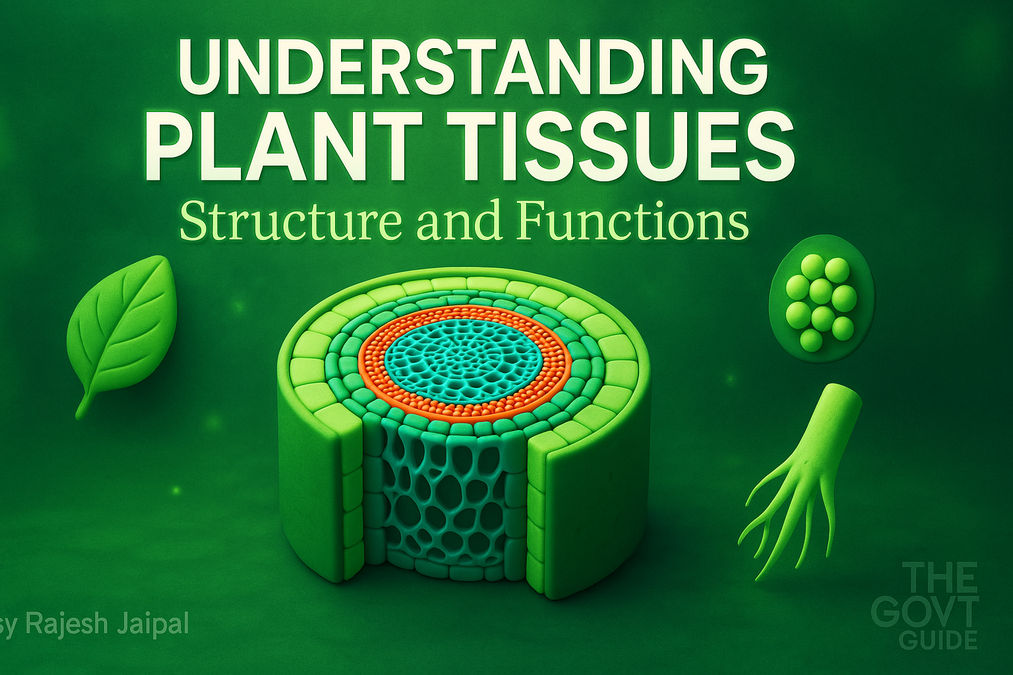Understanding Plant Tissues: Structure and Functions
Understanding Plant Tissues: Structure and Functions

Plants are fascinating organisms that rely on specialized groups of cells called plant tissues to perform essential functions like growth, support, and nutrient transport. In this article, we’ll explore the types of plant tissues, their structures, and their roles in ensuring plants thrive. Whether you're a student or a biology enthusiast, this guide will deepen your understanding of how plants function.
What Are Plant Tissues?
A tissue is a group of cells with similar structure and function working together to achieve a specific purpose. In plants, tissues are categorized based on their roles, such as growth, support, or transport. Unlike animals, plants are stationary, requiring unique tissues to support their structure and adapt to their environment.
Key Fact: Plant Tissues
Plant tissues are divided into two main types: meristematic (growth tissues) and permanent (specialized tissues). This division allows plants to grow and perform specific functions efficiently.
Types of Plant Tissues
Plant tissues are broadly classified into two categories: meristematic tissues and permanent tissues. Let’s dive into each type and their functions.
Meristematic Tissues: The Growth Engine
Meristematic tissues are responsible for plant growth. These tissues consist of actively dividing cells with dense cytoplasm, thin cell walls, and prominent nuclei. They lack vacuoles, which maximizes their division potential.
- Apical Meristem: Found at the tips of roots and shoots, it promotes vertical growth.
- Lateral Meristem: Responsible for increasing the girth of stems and roots.
- Intercalary Meristem: Found at the base of leaves or internodes, aiding in elongation.
Thought Box: Why No Vacuoles?
Meristematic cells lack vacuoles to maintain a high surface-to-volume ratio, enabling rapid cell division. Vacuoles, typically used for storage, would hinder this process.
Permanent Tissues: Specialized Functions
Once meristematic cells stop dividing, they differentiate into permanent tissues, taking on specific roles. Permanent tissues are further divided into simple and complex tissues.
Simple Permanent Tissues
Simple permanent tissues consist of one type of cell. They include:
- Parenchyma: Living cells with thin walls, used for storage, photosynthesis (chlorenchyma), or buoyancy (aerenchyma).
- Collenchyma: Living, elongated cells with thickened corners, providing flexibility and support.
- Sclerenchyma: Dead cells with thick, lignified walls, offering strength (e.g., coconut husk).
Complex Permanent Tissues
Complex tissues consist of multiple cell types working together. The two main types are:
- Xylem: Transports water and minerals; includes tracheids, vessels, xylem parenchyma, and fibers.
- Phloem: Transports food; consists of sieve tubes, companion cells, phloem parenchyma, and fibers.
Note: Vascular Tissues
Xylem and phloem form vascular bundles, enabling plants to survive in terrestrial environments by efficiently transporting water, minerals, and food.
Protective Tissues in Plants
The epidermis is a single layer of cells covering the plant, protecting it from water loss, mechanical injury, and pathogens. In desert plants, it may have a thick, waxy cutin layer. Stomata, small pores in the epidermis, facilitate gas exchange and transpiration, regulated by guard cells.
As plants age, the epidermis is replaced by cork, a protective tissue with dead, suberin-rich cells that prevent gas and water exchange.
Summary of Plant Tissues
| Tissue Type | Function |
|---|---|
| Meristematic | Cell division and growth |
| Parenchyma | Storage, photosynthesis |
| Collenchyma | Flexibility and support |
| Sclerenchyma | Strength and rigidity |
| Xylem | Water and mineral transport |
| Phloem | Food transport |
Frequently Asked Questions (FAQs)
Frequently Asked Questions
What is a plant tissue?
A plant tissue is a group of cells with similar structure and function, such as meristematic or permanent tissues.
What are meristematic tissues?
Meristematic tissues are actively dividing cells responsible for plant growth, found in regions like root and shoot tips.
What is the role of parenchyma?
Parenchyma stores food, performs photosynthesis (chlorenchyma), or provides buoyancy (aerenchyma).
What is collenchyma?
Collenchyma provides flexibility and mechanical support, with living cells and thickened corners.
What is sclerenchyma?
Sclerenchyma consists of dead, lignified cells that provide strength, like in coconut husks.
What is the function of xylem?
Xylem transports water and minerals vertically through tracheids, vessels, and fibers.
What does phloem do?
Phloem transports food from leaves to other plant parts via sieve tubes and companion cells.
What is the epidermis in plants?
The epidermis is a protective outer layer of cells, often with a waxy cutin coating in desert plants.
What are stomata?
Stomata are pores in the epidermis that facilitate gas exchange and transpiration, regulated by guard cells.
What is cork tissue?
Cork is a protective tissue with dead, suberin-rich cells that prevent water and gas exchange.
Why do desert plants have thick epidermis?
A thick epidermis with cutin reduces water loss, protecting desert plants from dehydration.
What is a vascular bundle?
A vascular bundle is a combination of xylem and phloem, enabling nutrient and water transport.
Where is apical meristem located?
Apical meristem is found at the tips of roots and shoots, driving vertical growth.
What is differentiation in plant tissues?
Differentiation is the process where meristematic cells develop into specialized permanent tissues.
How do plant tissues differ from animal tissues?
Plant tissues focus on support and transport due to their stationary nature, while animal tissues support movement and complex organ systems.
Conclusion
Plant tissues are the backbone of a plant’s structure and function, enabling growth, support, and nutrient transport. From meristematic tissues driving growth to permanent tissues like xylem and phloem ensuring survival, each plays a critical role. Understanding these tissues helps us appreciate the complexity of plants. Want to explore more? Check out our Biology Section or visit Tissue for in-depth resources.
Call to Action: Share your thoughts in the comments or try the onion bulb experiment at home to observe meristematic tissue in action!
© 2025 Biology Insights. All rights reserved.
Join the conversation